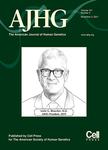版权所有:内蒙古大学图书馆 技术提供:维普资讯• 智图
内蒙古自治区呼和浩特市赛罕区大学西街235号 邮编: 010021

作者机构:Univ Utah Dept Human Genet Salt Lake City UT 84112 USA Univ Utah Dept Pediat Salt Lake City UT 84112 USA
出 版 物:《AMERICAN JOURNAL OF HUMAN GENETICS》 (美国人类遗传学杂志)
年 卷 期:2002年第71卷第3期
页 面:528-542页
核心收录:
学科分类:0710[理学-生物学] 07[理学] 09[农学]
基 金:NCRR NIH HHS [RR-00064, M01 RR000064] Funding Source: Medline NIEHS NIH HHS [ES-10058] Funding Source: Medline NIGMS NIH HHS [R01 GM059290, GM-59290] Funding Source: Medline
主 题:.SNPs human population noncoding Haplotype DNA sequence cytochrome diverse sequenced single-nucleotide kb region high-frequency CYP History and Natural Old World sample PDR sample
摘 要:CYP1A2 is a cytochrome P450 gene that is involved in human physiological responses to a variety of drugs and toxins. To investigate the role of population history and natural selection in shaping genetic diversity in CYP1A2, we sequenced a 3.7-kb region 5 from CYP1A2 in a diverse collection of 113 individuals from three major continental regions of the Old World (Africa, Asia, and Europe). We also examined sequences in the 90-member National Institutes of Health DNA Polymorphism Discovery Resource (PDR). Eighteen single-nucleotide polymorphisms (SNPs) were found. Most of the high-frequency SNPs found in the Old World sample were also found in the PDR sample. However, six SNPs were detected in the Old World sample but not in the PDR sample, and two SNPs found in the PDR sample were not found in the Old World sample. Most pairs of SNPs were in complete linkage disequilibrium with one another, and there was no indication of a decline of disequilibrium with physical distance in this region. The average +/- SD nucleotide diversity in the Old World sample was. The 0.00043 +/- 0.00026 African population had the highest level of nucleotide diversity and the lowest level of linkage disequilibrium. Two distinct haplotype clusters with broadly overlapping geographical distributions were present. Of the 17 haplotypes found in the Old World sample, 12 were found in the African sample, 8 were found in Indians, 5 were found in non-Indian Asians, and 5 were found in Europeans. Haplotypes found outside Africa were mostly a subset of those found within Africa. These patterns are all consistent with an African origin of modern humans. Seven SNPs were singletons, and the site-frequency spectrum showed a significant departure from neutral expectations, suggesting population expansion and/ or natural selection. Comparison with outgroup species showed that four derived SNPs have achieved high ( 0.90) frequencies in human populations, a trend consistent with the action of positive natural